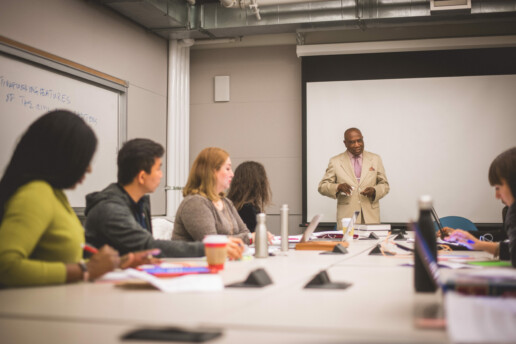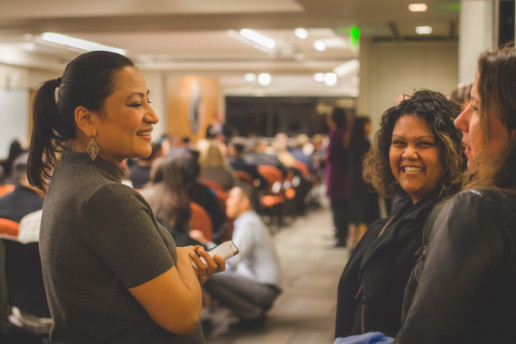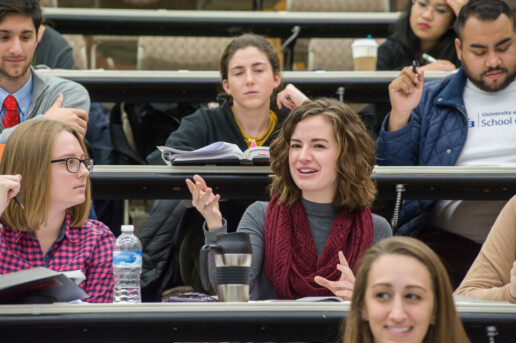Time Spent Caring for Others, Part 2
In our last post, we examined the differences in time spent caring for dependents among law students by age, gender, and enrollment status (part-time or full-time). In this post, we look at the stress and satisfaction levels of students with different levels of caretaking duties. Most law students report moderate to high levels of law school related stress and anxiety (3 or higher on a 7-point scale). Interestingly, there are virtually no differences in law school related stress levels among students based on the amount of time they spend caring for dependents. Students at all levels of caretaking responsibility are all equally stressed during law school, with around 50% having high levels and around 45% having moderate levels.
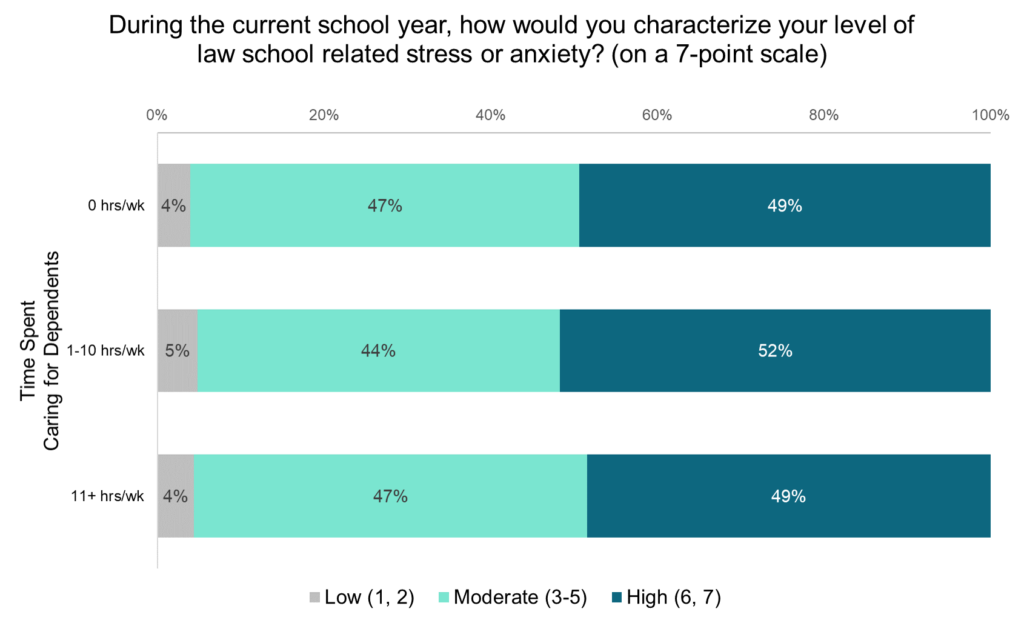
Law students with no, low, or high levels of time spent caring for dependents also report similar levels of satisfaction with the law school experience, with slightly more than a third saying their experience has been “excellent” and slightly less than half rating their experience as “good.”

However, students with varying levels of caretaking responsibilities do diverge in how they allocate their time among law school activities, work, and leisure. Nearly half (49%) of students with caretaking duties spend more than five hours per week commuting to class while only 37% of students without caretaking duties report the same. Students without dependents tend to spend more time on leisure activities such as socializing and exercising whereas students with dependents are more likely to work for pay and have longer commutes to class. This suggests that caretaking students meet the needs of their dependents at the expense of time that might otherwise be spent on self-care activities. This trade-off is similar to the findings of the LSSSE 2019 Annual Results, which show that women are performing well in law school but with higher costs to their physical and mental health relative to their male classmates. Non-caretakers are slightly more likely to spend at least five hours per week participating in law school activities while caretakers are somewhat more likely to engage in legal pro bono work not required for class and to participate in community activities. So when caretaking students have the ability to engage in extracurricular activities, they are likely to choose different activities than their non-caretaking classmates.
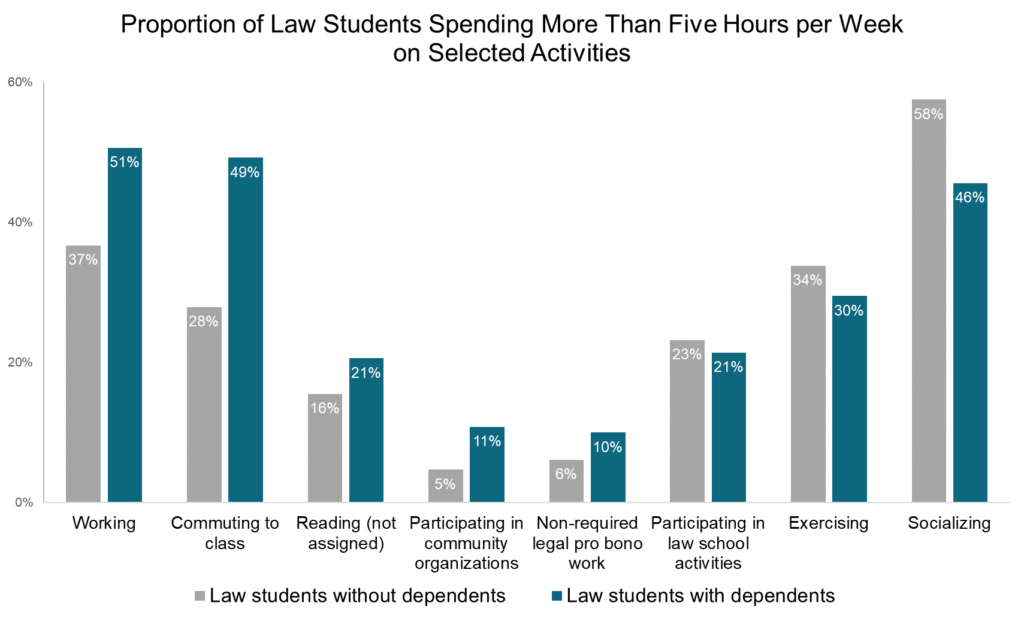
Clearly, the way students spend their time varies depending on whether they spend time caring for others during the week, even though both groups are remarkably similar in stress levels and overall satisfaction. This implies that students who differ in caretaking duties may adapt by taking advantage of different resources and strategies in order to make the most of their law school experience. Students who have greater caretaking duties are also more invested in other non-campus-related activities—including work, community organizations, and pro bono services. Though they spend less time socializing, they remain almost equally invested in participating in law school activities overall.
Time Spent Caring for Others, Part 1
Law students with support networks are more likely to be successful in their studies, but students who are interdependent with others may also bear substantial caretaking duties. In the analysis of how students use their time, LSSSE asks about how many hours per week respondents provide care for dependents living in their household (parents, children, spouse, etc.). We decided to dig into the data to see which students are most likely to spend time caring for others and how caretaking duties interact with measures of student stress and satisfaction.
Demographics of Caretaking
Among law students, men and women are equally likely to report spending some amount of time each week caring for dependents who live with them. Thirty-five percent of men and 36% of women spend at least one hour per week taking care of dependents. Students of other gender identities spend somewhat more time on caretaking duties, with almost half (47%) spending at least an hour per week.
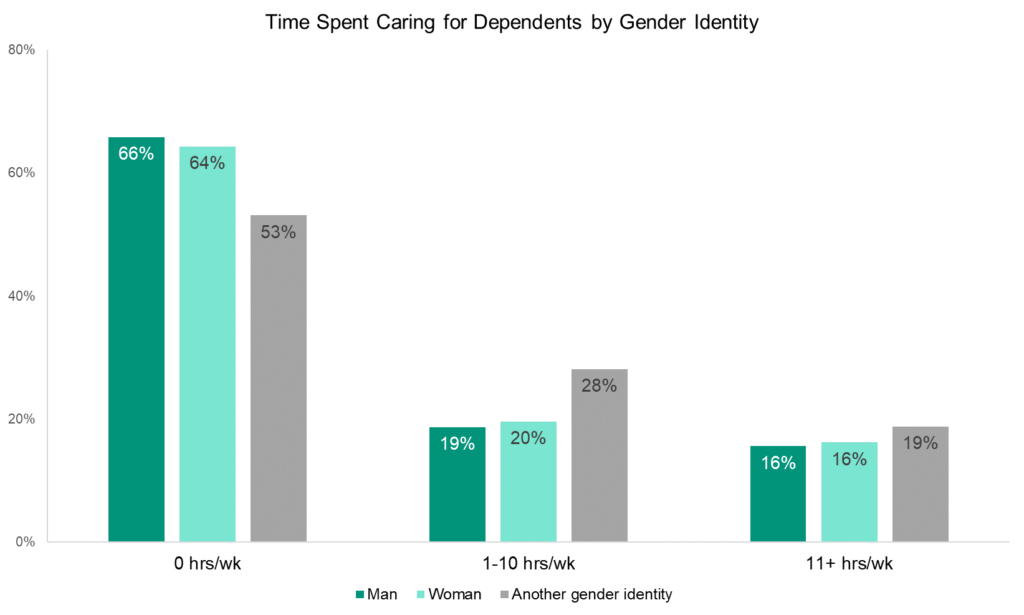
As law students get older, they tend to spend more time on caretaking tasks. About 77% of students 25 or younger spend no time at all caring for dependents during the week, but only 26% of students over 40 can report the same. In fact, about half of students over 40 spend eleven or more hours per week taking care of dependents. About 40% of students in their thirties have similarly intense caretaking roles, but that figure drops dramatically for students under 30.
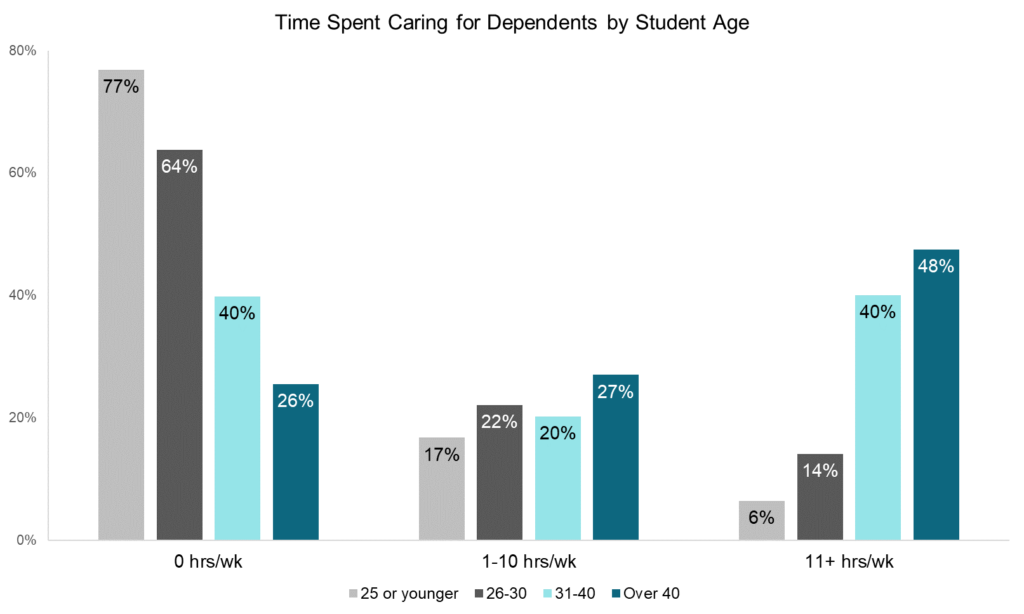
Part-time students are more likely than full-time students to spend some time each week caring for dependents. Fifty-six percent of part-time students report caring for dependents compared to 32% of full-time students. One-third of part-timers spend eleven or more hours per week caring for dependents while just 13% of full-timers report the same.
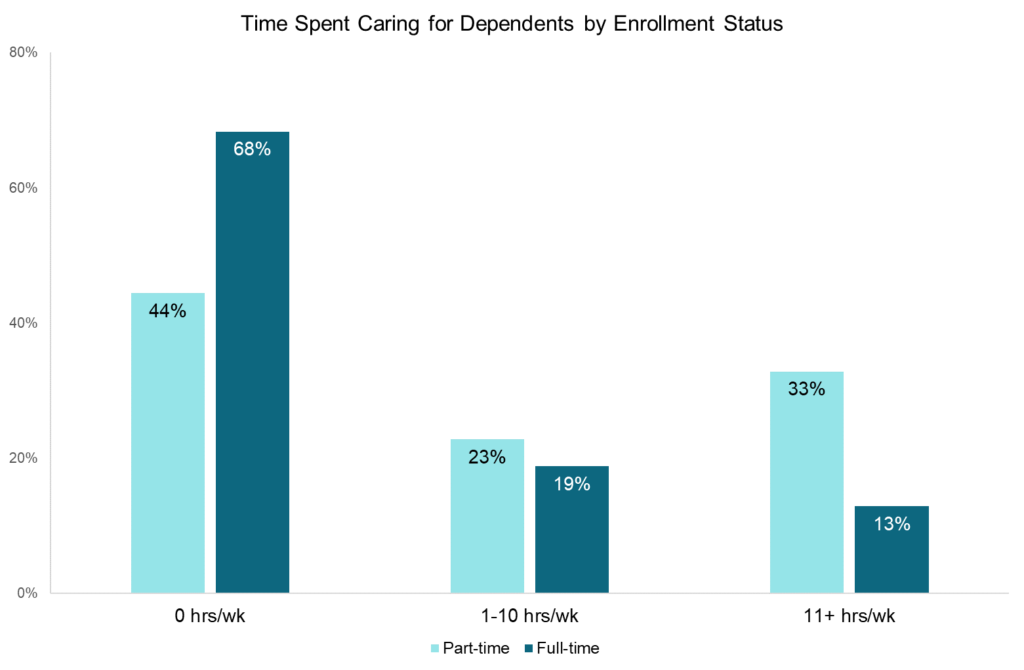
Overall, the LSSSE data show that there are variations in the time students spend caring for children, parents, and others. Older students and part-time students are more likely to spend time caring for dependents, relative to their younger and full-time counterparts. Interestingly, men and women are about equally likely to engage in caretaking duties. Next week, we will explore how caretaking responsibilities interact with law students’ stress levels and their overall satisfaction with the law school experience.
Guest Post: Some Tips for Improving Student-Faculty Relationships in Law School
Guest Post: Some Tips for Improving Student-Faculty Relationships in Law School

Susan Wawrose
Professor Emerita
University of Dayton School of Law
Law student distress remains an ongoing challenge for law schools. Always an important concern, student well-being deserves even greater attention now during this time of pandemic. Many law faculty saw this up close last March when they transitioned their classes on-line in response to the COVID-19 outbreak. Through the relentless lens of Zoom, it was hard not to notice that some students were struggling to cope. This may have been because of the abrupt change in environment or a loss of support systems as students were forced to leave campus, or it may have been simply a result of the general uncertainty that affected us all.
In any case, with the virus still rampant, as students return to classes this fall they are entering a brand new landscape. Many can expect some combination of socially distanced in-person learning and on-line classes and all will be asked to adopt new models and protocols for interacting with peers, faculty, and administration. Communication and connection with faculty members will be essential to students as they navigate this new reality. Strong faculty-student relationships have always been important in law school since healthy, appropriate relationships, including those with faculty mentors, both reduce distress and foster student achievement. Now, as the pandemic creates pervasive uncertainty, with its accompanying strains, positive faculty-student interactions can be supportive for all students and especially helpful for those who are feeling untethered, disconnected, or unsure.
Data from the Law School Survey of Student Engagement (“LSSSE”) indicate there is room for improvement in the quality of law student-faculty relationships. A comparison of LSSSE data from 2015-2019 shows that just over 50% of students ranked the quality of their relationships with faculty as especially positive. Students rate the quality of their relationships with faculty from 1 to 7 on a 7-point scale, where a higher rating is more positive, i.e., seven is “available, helpful, sympathetic” whereas 1 is “unavailable, unhelpful, unsympathetic.” Ratings of 6 and 7 are combined to create the “Top 2,” an aggregate of the most positive responses. From 2015-2018, the percentage of students reporting the quality of their relationships fell within the Top Two ranged only from 52% to 58%.
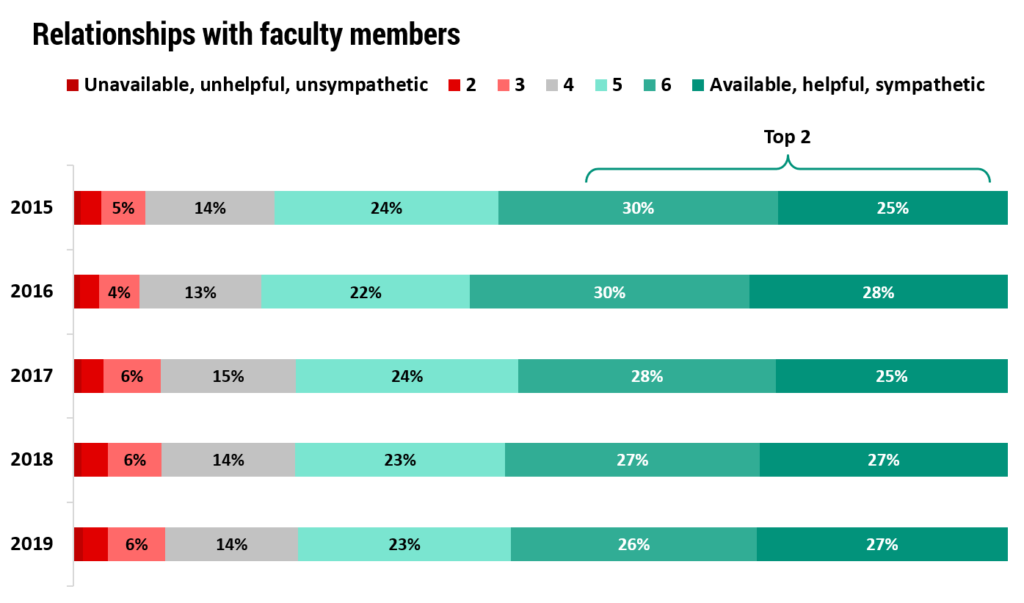
How law students have viewed their relationships with faculty members
With this in mind and with a new semester starting, there are some simple steps faculty can take to improve their relationships with students (both in-person and online) and to begin to develop strong, supportive connections. A full article on this topic is available here: https://papers.ssrn.com/sol3/papers.cfm?abstract_id=3088008
1. Take the time to develop rapport
Building rapport is a relatively simple way to connect with students that faculty can practice nearly every day. The value of building rapport is that it promotes trust and conveys acceptance, thus increasing the likelihood that a student will feel supported and connected.
The process of building rapport includes listening closely, being approachable, and encouraging open communication, so that students will feel able to speak freely and welcome to reach out again. Simple aspects of non-verbal communication such as making eye contact, smiling, and gesturing appropriately and naturally, can all be used to set a positive tone and to signal engagement and interest. It can be helpful to take a breath to center yourself when you begin talking with a student and to remind yourself to look up from your laptop, put down whatever you are working on, and attend to the person in front of you. In addition, building rapport includes appreciating individuality and difference in students, even if their appearance, communication strategies, or other personal qualities do not mesh with your expectations of how a law student should act or appear. Letting go of judgment is not always easy for lawyers, but this act of compassion in personal interactions can support students by creating a more open platform for communication.
2. Practice active listening
Engaged and active listening promotes connection because it communicates respect and caring. Just as with building rapport, it can take a shift of mindset to slow down and set the intention to listen deeply and respond with intention when students speak. But, this shift is valuable because active listening allows students to feel heard and understood.
Active listening involves listening with full attention to both the spoken content as well as the “hidden” messages behind statements. Attention to both verbal and nonverbal messages is important. Verbal and nonverbal communication can also be used to convey that the speaker is being both heard and understood. Non-verbal communication on the part of the listener can include making appropriate eye contact (versus checking your phone or rifling through papers on your desk) or using simple assurances like nodding or use of short words or phrases like “Uh-huh,” “Yes,” and “I see” to confirm understanding and encourage the speaker to continue. Moreover, allowing for some silence while listening can give the speaker time to process and reflect when communication does not flow easily.
Listening well to students is particularly important because, in addition to helping to build relationships, it provides faculty the opportunity to observe and notice when a student seems unusually troubled or unsettled. Thus, faculty who engage meaningfully with students may be the first observers of distress and may find themselves able to provide needed support or direct students to campus support networks.
3. Engage students with empathy
Empathy is an important lawyering skill often taught in clinical and dispute resolution courses. When students discuss their struggles, faculty can opt for an empathetic response to convey a sense of caring and interest in the student experience. Engaging students with empathy builds trust and understanding and supports students by communicating that their ideas and thoughts matter. Students feel heard, rapport is strengthened, and communicating may become easier. A faculty member’s empathetic response to student concerns can promote feelings of well-being and connection. In addition, and importantly, when faculty are empathetic in their communication with students, they model a way of being in a professional setting that students can draw on later in their careers as they seek to develop relationships with both clients and colleagues. That is, through observation, students learn an important professional skill.
By practicing these simple relational skills faculty provide additional support for students and may possibly reduce some of the unproductive and damaging distress students feel. Nudging the percentage of students who report extremely positive relationships with faculty even just a few percentage points higher would be a benefit for all.
Guest Post: Native American Exclusion as a Form of Paper Genocide
Guest Post: Native American Exclusion as a Form of Paper Genocide

Victoria Sutton
Member of the Lumbee Tribe
Texas Tech University School of Law
Recently, I applied for an NSF grant to survey the attitudes and perceptions of Native American scientists about human gene editing. The grant was rejected and one of the comments from a reviewer was essentially, “Why not include other ethnic and racial groups? Why just Native Americans?” I assumed I had done a poor job of explaining why this group would have culturally unique perspectives, and resubmitted. Needless to say, it was not funded.
The profound conclusion this reviewer must have made was that Native Americans have no different perspective from any other ethnic or racial minority group so why make any distinction since there is no value in asking “just” Native Americans their opinions.
The disappearance of Native Americans from statistical data for universities and law schools is not just a quirk of statistics. The word disappearance is intentional, and relates to the genocidal policies of first Great Britain and then the United States against the indigenous population in America. Not only was physical genocide embraced, but paper genocide as well, eliminating references to Native Americans in property records, census records, birth and death records in a paper genocidal policy.
There is no question about genocidal policies and the U.S. as a nation has denounced it and apologized for it, most recently President Obama. Paper genocide has been more subtle but generationally harmful. What amounts to a continuing theme of paper genocide, professional organizations, college data collectors and other observers leave Native Americans out of statistical data collection and reporting. Last year, I was able to find that the LSSSE study of law students included Native American students just as they considered other ethnic and racial groups, and I was able to access useful data for my own research.
From that data some important differences among racial and ethnic law students emerged from the question about how much time per week students spend caring for dependents. Native American law students spend considerably more time per week than other groups on dependent care. The data show that 36% of Native American law students spend more than 16 hours a week on dependent care (which includes taking care of children, parents, or grandparents) compared to 13% of Asian Americans, 18% of Black students, 14% of Latinx students, 20% of Native Hawaiians/Pacific Islanders, 11% of whites and 14% of multiracial students. This may explain why the data also show that Native Americans are more likely than others to say their schools contribute only “very little” to their non-academic responsibilities.
Figure 1. Time spent caring for dependents: More than 15 hours a week 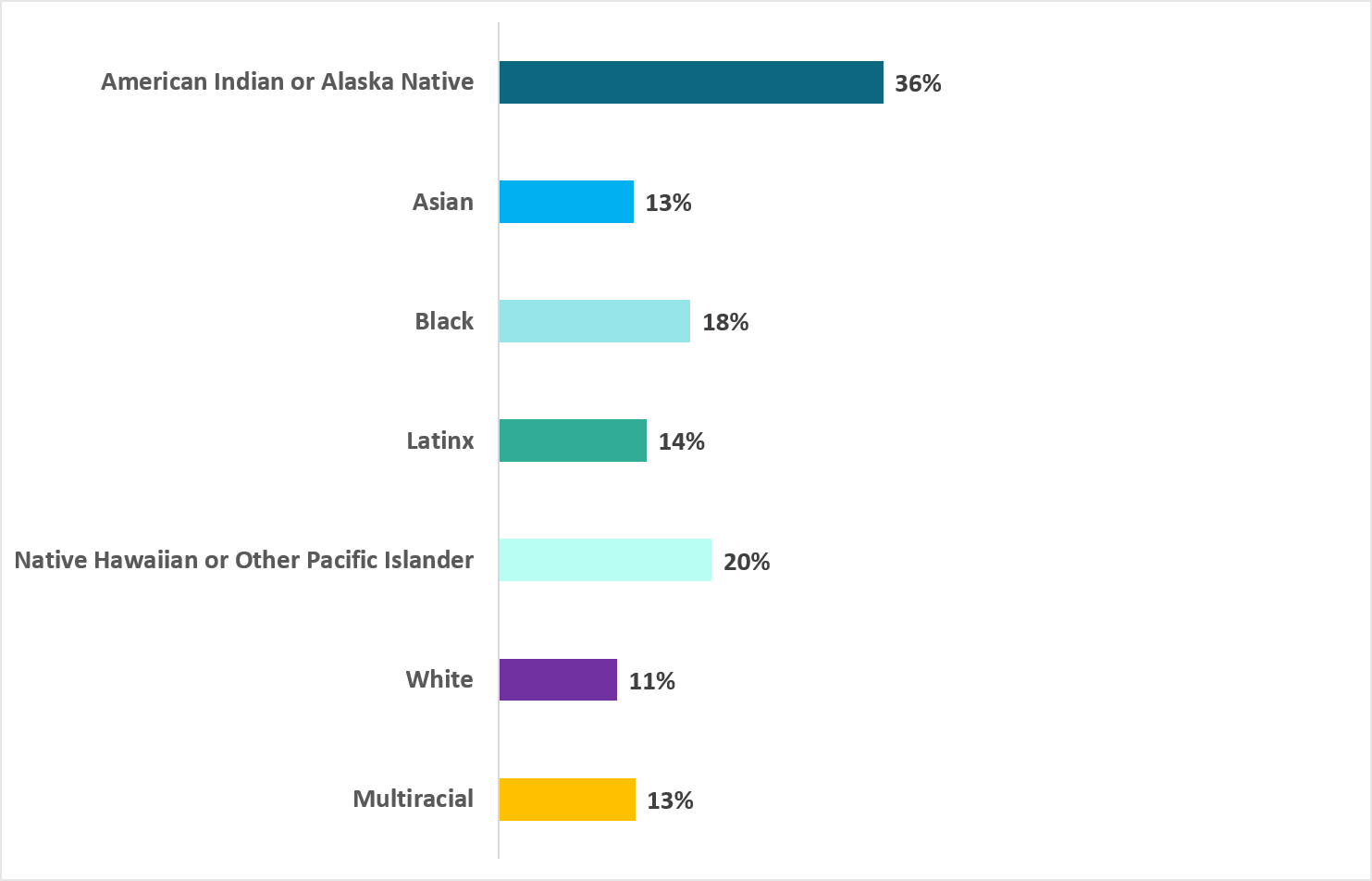
Because LSSSE has longitudinal data, it is clear that the high percentage of Native Americans who spend significant time on dependent care is consistent over time and not an anomaly just for 2019. The numbers are very small but we can still make some incredibly insightful findings with this data. Just reporting on “people of color” as one group would have masked this significant difference between Native Americans and other communities of color.
I was disheartened when the Princeton Review, a long time college guide for undergraduates, stopped collecting data on enrolled Native Americans at each university. Last year, I was shocked when a spokesperson from the American Institute of Architects (AIA) unapologetically announced to an annual meeting of Native American architects (AICAE) that they would no longer collect data on Native American architects as a distinct group—simply because it is a small group.
Recently, the NALP Foundation and the University of Texas at Austin School of Law, Center for Women in Law continued the unapologetic paper genocidal trend against Native Americans, when their report on “Women of Color: A Study of Law School Experiences” was released with the term “Native American” barely referenced in the entire 165-page report. They unapologetically proclaimed their study did not include Native Americans in the “Introduction” when they wrote, “The study further analyzes the experiences reported by women of color by Asian/Pacific Islander, Black/African-American, and Hispanic/Latina students.” The only mention of Native American data in the text of the report is on page 157 where they admit that this data simply disappeared into an amorphous group of “women of color,” without acknowledging how the experiences of Native Americans could be different from women of color as a whole.
This study, which received significant corporate sponsorship, could have allocated resources to oversampling Native American women students or finding other ways to include more Native Americans. The authors wrote in their “Introduction” that “ultimately, 46 law schools throughout the United States, joined by several law school affinity groups, agreed to participate in the study by distributing the survey instrument to their law students.” While convenient, this sampling procedure is flawed. As an academic who uses empirical methods in my research, I am shocked the authors did not use any methods to reach a population they knew was underrepresented in law school only to claim in their report that “low response numbers from other cohorts precluded reporting those results separately.” The problem is not low response rates, but flawed methods.
To avoid paper genocide, researchers have an obligation to be purposeful in their methods to reach and include Native Americans and share their disaggregated perspectives as part of reported findings. When researchers do not do this, at worst, they continue the practice of paper genocide and at best, it is an unapologetic microaggression.
To illustrate what being visible means to the Native American community, the title of the 2019 American Indian College Fund equity initiative is, “Creating Visibility and Health Learning Environments for Native Americans in Higher Education.”
[I]nvisibility is in essence the modern form of racism used against Native Americans. It is this invisibility that leads to a college access and completion crisis among Native American students. When a student is invisible, his or her academic and social needs are not met. This leads to students feeling alienated and alone, derailing their matriculation and the realization of their dreams and potential.
Quite simply put, any study purporting to be about “women of color” or “people of color” should include disaggregated data on Native Americans, too. To miss this point, is not only to engage in, but to embrace paper genocide of Native Americans.
Guest Post: Student-Faculty Interactions: A Closer Look at the Office Hour

DeShun Harris
Assistant Clinical Professor of Law & Director of Bar Preparation
The University of Memphis Cecil C. Humphreys School of Law
Student-faculty interaction is an important component of law school. Indeed, LSSSE data indicate that the majority of students engage with faculty on matters other than coursework. In thinking about the many ways in which faculty engage with students whether in advising, academic support, mentoring, coaching, and office hours, it is important to consider how one-on-one meetings with students can be fruitful. As it relates to office hours specifically, because they are a requirement of the ABA, it’s important that think about the ways in which office hours can be conducive to learning and expand what is known about them.
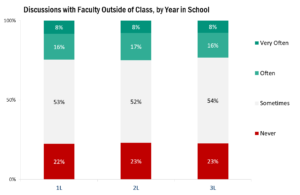
My research of office hours unveiled how to enhance office hours: overcoming underutilized office hours, creating a welcoming office, understanding the office hour framework, and creating a learner-centered collaborative environment. While much of the formal published article focuses on the framework of office hours and creating a learning-centered environment, for readers here, I think it’s important to focus on overcoming underutilized office hours and creating a welcoming office. In other words, let’s think about how students are encouraged to attend office hours. This becomes of particular importance to ensure some students aren’t missing out on critical faculty-student interactions. It is important, given the changing times, that one considers how the office hour might be adapted especially when we return for Fall 2020.
Encouraging Attendance: Invite Students Directly
Students have perceptions about office hours that are often the result of past experience or perceptions of their professor. For example, some students may believe office hours are only for students who are struggling. Some other students may believe professors are unapproachable or unavailable. There are many reasons why students may choose not to attend office hours even when they may be beneficial. With many students returning or beginning law school remotely, breaking down those perceptions is going to be very important when other types of faculty-student interaction might be reduced or changed (e.g., talking to students immediately after class, bumping into students in hallways, or chatting with students at events). This will make engaging some students in the office hour more important.
Professors can address these perceptions and circumstances by being intentional about inviting students to their office hours. For example, place a statement in the syllabus that explains the purposes of office hours (e.g., to ask questions, to explore ideas beyond the scope of class, to strengthen their analytical skills, or to learn more about the profession). Professors can reaffirm office hours by inviting students to visit periodically through the semester by expressing it during lectures or through emails or postings to the learning management system. My research also indicates that giving meaningful feedback can be a useful way of increasing the usage of office hours by students even more so than creating a welcoming environment; as professors think about assessments, they may find more students come as they provide feedback.
The Office Setting: Make it Comfortable
While it may be a while for some law schools to begin in-person teaching, when it does begin professors should be aware that the physical office sends implicit messages to students. A messy office with papers strewn about can communicate busyness and that the student is taking up valuable time. An office that creates a great deal of space between student and professor can communicate a clear divide between the two, making it difficult for the student to share honestly. Finally, for some students, coming to a physical office can be intimidating or less accessible.
Professors can make their offices and themselves appear more accessible by minimizing clutter, minimizing computer screens, and silencing phones. These small steps can help the student feel invited rather than feeling they are a distraction. To the extent possible, professors should structure their offices in a way that communicates collaborations rather than a hierarchical barrier between professor and student. Where it isn’t possible to close spacing due to social distancing, alternatives can include situating one’s self side by side or sitting at a round table to keep an appropriate distance but feeling closer or collaborative.
Alternatives to the Office: Online Options Work Too
This past semester, many professors learned that the physical office hour isn’t the only way to meet students. Using email or instant messaging can be a good way to reach those students who may be unable to attend physical office hours. But research suggests that email can sometimes be read with unfavorable biases toward minorities and women. It is important to create clear policies for the appropriate use of email to avoid unyielding chains of emails or questions that may be more appropriate for discussion. Professors may also create policies related to when emails will be answered to alleviate the stress of feeling a need to respond.
Phone calls and videoconferencing are great tools that if used properly can replicate the in-person office hours. More research is needed to evaluate the best practices for doing so, but professors should think about what they are asking of students if they request students to appear on screen (for some students it could be breaking a barrier between home and professional life that they aren’t willing to cross due to shame or privacy concerns). And meeting students in locations other than one’s office like common spaces can also serve to break down barriers and create more accessibility. Alternatively, professors may consider reserving larger spaces that allow groups of students to meet with the professor which may also reduce any barriers the student may have.
Conclusion
Office hours are an important part of student-faculty interactions. Professors might consider ways in which they can enhance office hours and make them more available and welcoming to their students. With the changes brought by COVID-19, it is now more important that professors evaluate the ways in which they adapt online versions of our office hours or meetings we have with students, and also give thought to what future in-person office hours might look like.
___
References:
DeShun Harris, Office Hours Are Not Obsolete: Fostering Learning Through One-on-One Student Meetings, 57 Duquesne L. Rev. 43 (2019).
ABA Standard 404(a) (1), http://www.americanbar.org/content/dam/aba/publications/misc/legal_education/Standards/2016_2017_standards_chapter4.authcheckdam.pdf.
Looking Ahead: Assessment in Legal Education Annual Results 2014, http://lssse.indiana.edu/wp-content/uploads/2016/01/LSSSE_2014_AnnualReport.pdf.
Rosemarie Arbur, The Student-Teacher Conference, 28 College Composition and Communication 338 (1977).
Elaine S. Barry, Using Office Hours Effectively, Observer, June/July 2008.
Whitney Griffin, et. al, Starting the Conversation: An Exploratory Study of Factors That Influence Student Office Hour Use, 62 College Teaching 94 (2014).
Mario Guerrero and Alisa Beth Rod, Engaging in Office Hours: A Study of Student-Faculty Interaction and Academic Performance, 9 Journal of Political Science Education 403 (2013).
Lydia Eckstein Jackson and Aimee Knupsky, “Weaning off of Email”: Encouraging Students to Use Office Hours over Email to Contact Professors, 63 College Teaching 183 (2015).
Robin S. Wellford-Slocum, The Law School Student-Faculty Conference: Towards A Transformative Learning Experience, 45 S. Tex. L. Rev. 255, 262 (2004).
Guest Post: Empirical Sociolegal Research and the Use of LSSSE Data
Guest Post: Empirical Sociolegal Research and the Use of LSSSE Data

Ajay K. Mehrotra
Director & Research Professor
American Bar Foundation
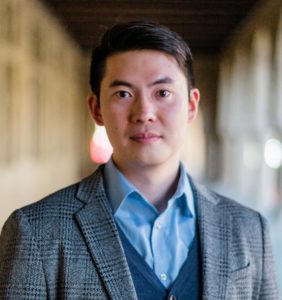
Shih-Chun Chien
Research Social Scientist
American Bar Foundation
Thanks to Meera Deo and everyone at the Law School Survey of Student Engagement (LSSSE) for the opportunity to contribute to the blog. As most readers of this blog know, LSSSE provides a unique and in many ways unparalleled dataset on the law student experience across both time and place. Simply put, LSSSE is a treasure trove of valuable data for scholars studying legal education and the legal profession, as well as for law school administrators seeking to learn more about the law student perspective. In previous blog posts, several of our American Bar Foundation (ABF) colleagues have described how their long-term empirical and interdisciplinary research projects have benefited from access to LSSSE data. In this post, we would like, first, to underscore what makes LSSSE data special and valuable for empirical, sociolegal scholars studying legal education and the profession. Second, we describe the ABF and what sets it apart as a non-profit, non-partisan, independent research institute focusing on law. Finally, we conclude by discussing a recent ABF project on diversity and inclusion that leverages LSSSE data to explore law student career preferences and expectations about judicial clerkships.
The Uniqueness of LSSSE Data
Last year marked LSSSE’s 15th year anniversary. In that decade and a half, LSSSE has collected responses from over 370,000 law students from roughly 200 law schools across the United States, Canada, and Australia. Survey respondents represent a broad cross-section of law students from a variety of law schools and countries. What began in 2004 as a modest research project at the Indiana University Center for Postsecondary Research has successfully evolved into the largest dataset of law student survey responses in existence. LSSSE’s annual survey results provide law schools and researchers with a unique, comparative perspective on student views and perceptions, allowing administrators to see how student attitudes at their school might correspond with and differ from peer schools and national averages.[1] Likewise, because LSSSE provides longitudinal data, using nearly identical questions in surveys over time, consumers of LSSSE data can measure continuity and change in student perceptions and beliefs. In short, the scale and scope of LSSSE data is remarkable.
There are, to be sure, other organizations that collect data about legal education and law students. The American Bar Association (ABA), the National Association of Law Placement (NALP), and individual law schools themselves gather a tremendous amount of information, from admissions statistics to employment placement numbers. And some law schools survey their own students about their educational experiences. But LSSSE, as our ABF colleague Stephen Daniels notes in his blog post, provides not just information about students but information directly from students. The surveys give students a voice.
In addition to generating distilled data from its annual survey, LSSSE also provides an invaluable service by publishing highly accessible annual reports. By translating social science findings into lay terms, LSSSE researchers highlight particular themes and patterns about the law student experience based on survey results. In recent years, annual reports have examined the challenges and opportunities faced by women law students; the importance of relationships with faculty, staff, and fellow students; and student employment preferences and expectations, among other significant topics.
ABF Empirical Research
LSSSE data and reports are particularly salient for the type of empirical and interdisciplinary research conducted at the ABF. Established in 1952 as an independent non-profit, non-partisan research organization, the ABF is among the world’s leading research institutes for the study of law, legal institutions, and legal processes. Among the ABF’s three main areas of research, the one that is most closely connected to LSSSE is our work on “Learning & Practicing Law.”[2] Within this research portfolio, we have several ABF scholars who are investigating an important array of legal education topics, from Stephen Daniels’s study of student assessments of law schools to C.J. Ryan’s work on the financing of legal education. Each of these rigorous and sophisticated empirical research projects is examining long-term trends in legal education – trends that can only be identified and analyzed with the type of data administered by LSSSE.
LSSSE data complements the ABF’s core research mission. The data help scholars, at the ABF and elsewhere, address some of the most pressing issues facing the legal system, including legal education. To tackle empirical questions about the quality, value, and impact of legal education, for instance, one must have access to data – data about how students have perceived and responded to their law school experiences. One new ABF research project that harnesses LSSSE data in this way is our study of diversity and inclusion (or lack thereof) in judicial clerkships.
The ABF’s Recent “Diversity and Judicial Clerkships” Project
In 2019, the ABF launched a new project (Portrait Project 2.0) exploring how Asian Americans are situated in the legal profession. This new ABF research follows up on an earlier study (A Portrait of Asian Americans in the Law) led by the Honorable Goodwin Liu of the California Supreme Court, in collaboration with Yale Law School and the National Asian Pacific American Bar Association (NAPABA). The ABF-led Portrait Project 2.0 delves deeper into the many challenges and opportunities faced by the Asian American legal community. The project aims to understand the factors that shape the careers of Asian American lawyers. One of the aims is to understand why Asian Americans are not reaching the upper echelons of the profession – from judicial clerks, to law firm partners, to top prosecutors and judges, to law school deans and non-profit executives.
As part of Portrait Project 2.0, ABF researchers and collaborating scholars are investigating why women and minority law students do not secure clerkships in proportion to their numbers at top law schools. Existing literature on judicial clerkships has identified the persistent lack of gender and racial diversity in federal judicial clerkships.[3] Despite the growing interest in diversity and inclusion in the profession, we currently lack a fundamental, baseline understanding of different components of the judicial clerkship “pipeline.”
Before we can provide answers to some of the diversity challenges, we must identify and analyze the factors that have facilitated or frustrated the goals of diversifying judicial clerkships. We believe there are at least three critical mechanisms that contribute to the disparities in judicial clerkships: (a) self-selection by students based on personal preferences, perceptions, family expectations, occupational choice, or ambient signals; (b) advising and mentoring by law school faculty, staff, and administrators; and (c) selection by judges.
Because LSSSE provides longitudinal data on race and gender, and students’ career preferences and expectations, its value to our project is twofold. First, it provides an empirical baseline of overall student perceptions versus expectations. A recent LSSSE annual report, for instance, demonstrates that judicial clerkships are frequently more aspirational than expected career goals, especially for women and minority students. Second, LSSSE highlights the imminent need for original data about the institutional support mechanisms for law students, including how law schools track, advise, encourage, and mentor students interested in pursuing judicial clerkships.
Generally, clerkships are an appealing career path for those law students interested in working in “public service settings.” According to a recent LSSSE annual report, among the 36% of law student respondents who preferred to work in a “public service setting,” obtaining a judicial clerkship was the second most sought after public setting, behind “government agency” and ahead of “public interest group.” Perhaps more saliently for our nascent study, the survey also found that there was a significant spread between respondents’ “preferences” for a clerkship and their “expectations” that they would secure such employment – a spread that was larger than any other public service settings. This suggests that law students overall believe that a clerkship is frequently an aspirational goal [see Chart 1].
Chart 1: Proportion of Respondents Preferring and Expecting Public Service Settings

The LSSSE report also highlights how race and gender play an important role in career preferences and expectations. The 2017 report found that White and Asian American students preferred judicial clerkships more than other racial groups. The overall picture on gender differences was even more pronounced. Not only did men prefer judicial clerkships more than women; when it came to career expectations, men continued to have judicial clerkships as their second expected public setting, whereas for women, judicial clerkships dropped out of the top three public setting career expectations. Our ABF research team is in the process of analyzing subgroup differences and more recent LSSSE data on career preferences and expectations to measure more precisely the gap between preferences and expectations and to explore whether these beliefs have continued or perhaps changed over time.
Conclusion
In sum, LSSSE data is an extraordinary asset for a vast array of research questions about law student preferences, expectations, and experiences. With its student-centered approach and rigorous design, LSSSE has advanced our understanding of numerous aspects of legal education and the profession. Still, LSSSE remains an underutilized source for serious and sophisticated empirical, sociolegal research. While many ABF scholars have been mining LSSSE data for the past decade, there is much more that other researchers could be doing with LSSSE. Our recent ABF project on diversity and judicial clerkships is just one modest example of how LSSSE data can be leveraged to tackle some of the most pressing concerns facing legal education and the profession. We hope other empirically oriented scholars will join us in engaging with, and making use of, LSSSE data.
____________________
[1] In a recent LSSSE blog post, American University Washington College of Law Dean Camille Nelson accurately referred to such use of LSSSE as “data-driven deaning,” available at: https://lssse.indiana.edu/blog/guest-post-towards-data-driven-deaning/.
[2] The ABF’s three core areas of research are: (1) Learning & Practicing law; (2) Protecting Rights and Accessing Justice; and (3) Making & Implementing Law. For more on the ABF’s research mission and examples of its research please visit the ABF website at: http://www.americanbarfoundation.org/index.html.
[3] NALP, “Bulletin: Increasing Diversity of Law School Graduates Not Reflected Among Judicial Clerks” September, 2014, available at: https://www.nalp.org/0914research; Danielle Root, Jake Faleschini, Grace Oyenubi, “Center for American Progress: Building a More Inclusive Federal Judiciary” October 3, 2019, available at: https://www.americanprogress.org/issues/courts/reports/2019/10/03/475359/building-inclusive-federal-judiciary/; Todd Ruger, “Law.com: Statistics Show No Progress in Federal Court Law Clerk Diversity” May 2, 2012, available at: https://www.law.com/nationallawjournal/almID/1202551008298&Federal_courts_making_no_progress_regarding_law_clerk_diversity_numbers_show/.
Guest Post: Rising With the Tide: Using National and Off-Cycle LSSSE Data to Improve Practice and Scholarship
 Rising With the Tide: Using National and Off-Cycle LSSSE Data to Improve Practice and Scholarship
Rising With the Tide: Using National and Off-Cycle LSSSE Data to Improve Practice and Scholarship
Trent Kennedy, MA, JD
National LSSSE data are a valuable and oft-overlooked resource to improve scholarship and data-informed practice. Their free online Public Reporting Tool gives everyone access to aggregated data from the last eight years of LSSSE administrations, allowing for quick checks and relatively detailed dives. Researchers and administrators who are interested in testing assumptions, building theories across data sources, and leveraging national norms should keep it in mind as their projects take shape.
The demographics of LSSSE participants reflect those of US law students overall (at least as of 2017). A total of 181 US law schools have participated in LSSSE since 2004, and each year’s cohort contains law schools from up and down the US News and World Report ratings (and one of my favorite data visualizations in legal education reminds us that it is a rating), capturing institutional diversity as well as student demographics.
Student Affairs professionals, faculty members, and administrators can use the Public Reporting Tool for a number of different useful functions, which are especially powerful when combined with school-specific data.
Testing Assumptions
National LSSSE data allow users to test myths, assumptions, and meso-ideas about law student characteristics and experiences. For example, after noting that 27.1-29.2% of LSSSE participants between 2014 and 2019 reported being first-generation college graduates, Georgetown Law began to investigate the experiences of our own first-generation students, law student affairs professionals from across the country engaged more deeply with the NASPA Center for First-Generation Student Success, and the AALS Section on Student Services is exploring a collaborative program about the needs of first-generation students writ large. As the old assumptions about our student populations become less and less useful, local and national data will help identify needs and marshal resources for the future of legal education.
National LSSSE data also show a consistent decline in overall satisfaction and preference for the same law school as JD students progress from 1L to 3L year. Students in their 3L year will certainly have more experience with and information about their law school, but local data are needed to know if they will really be the best boosters to alumni or prospective students.
Norming
The converse of assumption testing is establishing norms that can be leveraged to influence student behavior. Social norming is a common technique in public health communication, often used to combat perceived isolation as a barrier to healthier behavior. In 2017, my office was struck by the national data around the LSSSE core survey question 6c “In your experience at your law school, how satisfied are you with: Personal counseling?”. Of 20,574 students surveyed that year, 9,132 indicated that they had not used personal counseling while in law school. The actual satisfaction of the remaining 11,442 students ran the gamut, but careful observers will note that 55.6% of JD students participating in LSSSE indicated some uptake of personal counseling services (as distinguished from academic advising, career counseling, and financial aid advising). With so many of our students convinced that they are the only one struggling, seeing flyers around campus with a majority message to the contrary is a powerful sign that vulnerability and help-seeking are nothing to be ashamed of.
In the same vein, national LSSSE data on law student time use helped us build a norming campaign intended to reduce students’ overall stress and sense of time famine (the belief that you have too much to do and too little time to do it all). A quick run through the 2017 LSSSE data showed us that 1Ls spend an average of 31.93 hours per week reading and preparing for class. With 15 hours of weekly classroom instruction for Georgetown Law 1Ls at the time of the project and even factoring in a full night’s sleep each night, that leaves students with plenty of hours per week of waking time not spent in class or studying. That should be around 65 hours to enjoy their meals, visit the gym, talk with their families, or explore the community around them. From our conversations with students and other LSSSE data, we know they don't feel like they have that much time and spend their hours according to that feeling. We wanted to break them out of the cycle of stress and time famine. We presented the LSSSE data on time spent studying and the ensuing arithmetic on other available time during 1L Orientation in the hopes of relieving perceived time pressure, encouraging self-sustaining behavior, and restoring a sense of control to our 1Ls’ lives. A minority of the student feedback still showed the perennial hobgoblin of anxious peer comparison, but the response from the majority of students (and a few visiting alumni) was positive. They wanted the intended outcome and trusted a norm articulated with national data.
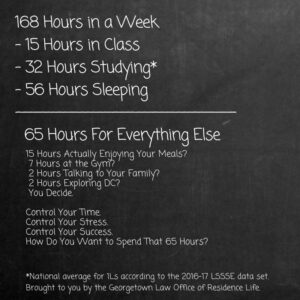
Scholarly Corroboration, Synthesis, and Theory-Building Across Data Sets
National LSSSE data can also be used to corroborate or support local data, allowing for the development of theories across multiple data sets. Law student stress has been a perennial topic of interest, rising in perceived importance as post-recession career pressure continues to haunt current students. Segerstrom’s idiosyncratic instrument revealed time pressure, difficulty of material, and lack of feedback to be chief concerns of law students in the late 1990s but “academic environment” was not. National 2015 LSSSE data from a special module on law student stress reported both the overall level of stress and the major sources of that stress, finding that academic performance and academic workload were the most common concerns while classroom environment/teaching methods was the least common. Flynn, Li, and Sánchez’s 2019 study of law student stress found that workload pressure was the strongest predictor of law student distress, but that course design and grading failed to show statistically significant relationships with the expected distress outcomes. Interested scholars might struggle to meaningfully synthesize Segerstrom and Flynn et al. without the intervening LSSSE data that facilitate a clearer focus on student perceptions rather than the institutional structures that produce them.
Even without timely local data, national and off-cycle LSSSE data enhance other avenues for scholarship and practice. By making the most of that data, legal educators can check their assumptions about student demographics and behavior, make new norms visible to change student attitudes, and connect other data sets into a more coherent (and actionable) landscape. Scholars and practitioners would do well to consider national LSSSE data when looking for insights on a proposal, program, or institutional problem.
LSSSE Annual Results 2019: The Cost of Women’s Success (Part 4)
The Troubling Secret to Success
What is the secret to the success of female law students? They enter law school with fewer resources and amass significant burdens once enrolled, but perform at equal or higher levels than their male peers along many metrics. The data suggest one clear answer: women law students work extraordinarily hard, juggling their various personal and academic responsibilities at the expense of self-care. While most students work hard to meet the high expectations of their professors, women students report sustained effort at higher levels than their male peers. A full 68% of women note that they “Often” or “Very Often” worked harder than they thought they could to meet faculty members’ standards or expectations, compared to 60% of men. Similarly, higher percentages of female students than male rise to the challenge of submitting their best work on exams. LSSSE respondents were asked to report “the extent to which your examinations during the current school year have challenged you to do your best work” on a 7-point scale. Remarkably, 44% of women report the highest level of engagement (a 7 out of 7) as compared to 36% of men. Again, these findings of hardworking women are consistent across race/ethnicity.
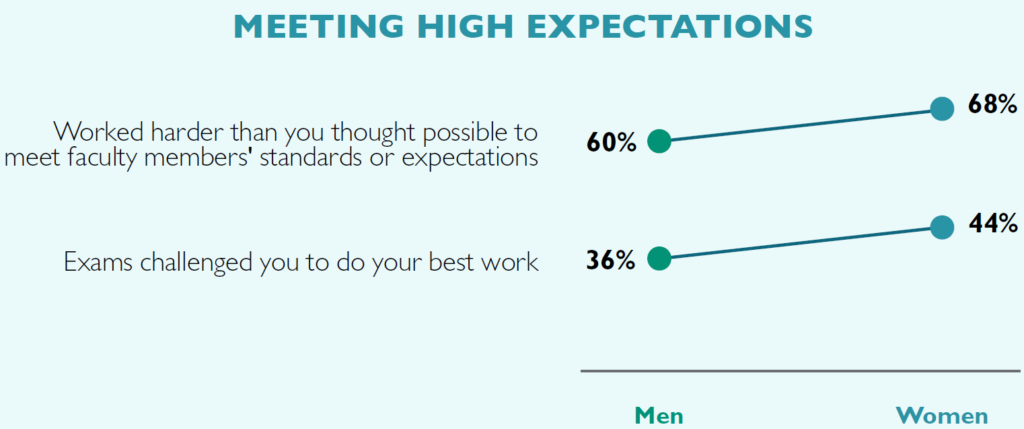
Tragically, the hard work that women dedicate to enabling their success comes at a significant cost. The tradeoff is that women are much less likely than men to engage in important social, leisure, and self-care activities. Each of these findings is consistent across racial/ethnic groups when comparing women with men. For instance, 41% of women spend zero hours per week reading for pleasure, compared to 25% of men. Similarly, the overwhelming majority of women law students find little time for physical fitness, with 74% reporting that they exercise no more than 5 hours a week (along with 60% of men). Expanding this concept to other leisure activities—including watching TV, relaxing, or even partying—does not improve this gender disparity. More than half (53%) of women law students spend five or fewer hours per week engaged in any of these social activities, compared to just over a third (38%) of men. Furthermore, half (51%) of women report sleeping five or fewer hours per night in an average week, along with 43% of men. In the scramble to get ahead academically, women are overlooking downtime; they are prioritizing their academic success at the expense of their own wellbeing. Such limited opportunities to disconnect from schoolwork, engage in physical fitness, rest, relax, and socialize with others can have serious implications for the long-term physical and mental health of women law students.
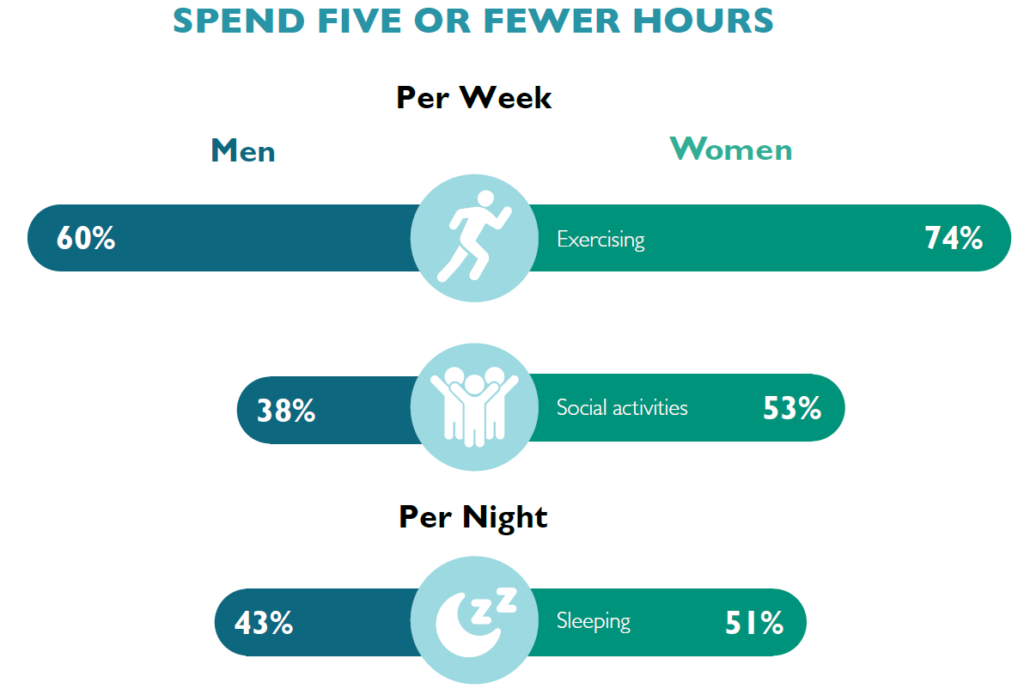
For more in-depth analysis about gender disparities in legal education, you can read the entire LSSSE 2019 Annual Results The Cost of Women’s Success (pdf) on our website or contact us.
LSSSE Annual Results 2019: The Cost of Women’s Success (Part 3)
Opportunities for Improvement
Given the many challenges facing women upon entry to law school, it is no surprise that there are also opportunities to improve the experience for women students in legal education. LSSSE data on concepts as varied as classroom participation, caretaking, and debt make clear that women need greater support.
Engagement in campus life is an especially significant indicator of success. Law students who are deeply invested in both classroom and extracurricular activities tend to maximize opportunities for success overall. As stated in a previous post, women are just as likely as men to be involved in various co-curricular endeavors. Yet, smaller percentages of women than men are deeply engaged in the classroom. While 64% of men report that they “Often” or “Very Often” ask questions in class or contribute to class discussions, only 58% of women do. This gender disparity remains pronounced within every racial/ethnic group, as men participate in class at higher rates than women from their same background. There are also interesting variations by raceXgender, with Black men frequently participating at higher rates than any other group (69%), and at almost twice the rate of Asian American women (38%).
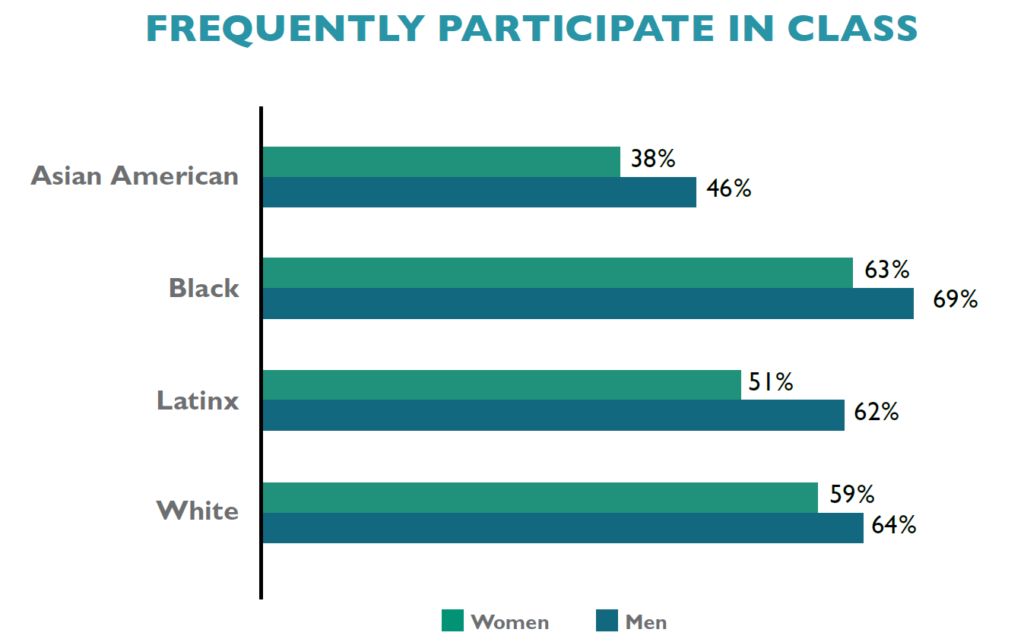
Many women students also spend numerous hours during their law school careers providing care to household members. For instance, 11% of women report that they spend more than 20 hours per week providing care for dependents living with them, as do 8.6% of men. These competing responsibilities require a significant investment of time, which could otherwise be spent on studying for class, working with faculty on a project outside of class, or even engaging in leisure activities. Instead, these students are taking care of their families.
An especially troubling discovery is that high percentages of women than men incur significant levels of debt in law school. Among those who expect to graduate from law school with over $160,000 in debt are 19% of women and 14% of men. This gender difference remains constant within every racial/ethnic group. Even more alarming is the disparity among those carrying the highest debt loads: 7.9% of women will graduate from law school owing over $200,000 as compared to 5.5% of men. LSSSE data not only confirm existing research on racial disparities in educational debt, with people of color and especially Black and Latinx students borrowing more than their peers to pay for law school, but also reveal that women carry a disproportionate share of the debt load as compared to men. Furthermore, when considering the intersection of race/ethnicity and gender, we see that women of color specifically are graduating with extreme debt burdens.
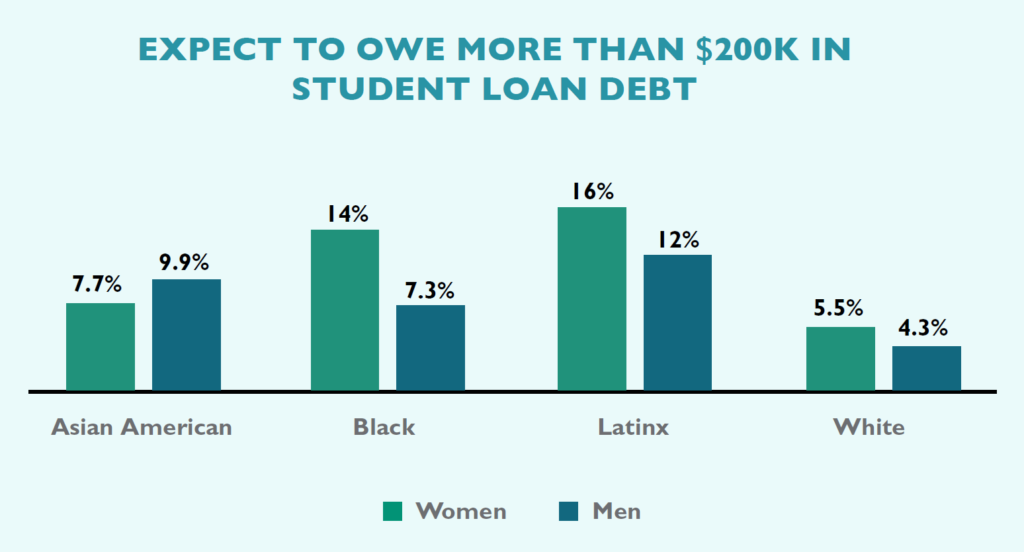
Next week, we will conclude this series with some troubling trade-offs that women make to overcome the disadvantaged position in which they often find themselves relative to their male counterparts. You can read the entire LSSSE 2019 Annual Results The Cost of Women’s Success (pdf) on our website.



